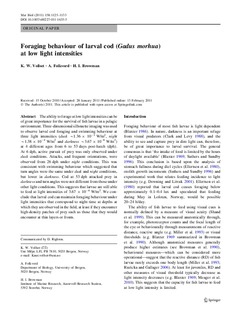Foraging behaviour of larval cod (Gadus morhua) at low light intensities
Journal article, Peer reviewed
Permanent lenke
http://hdl.handle.net/11250/117231Utgivelsesdato
2011-02-13Metadata
Vis full innførselSamlinger
Originalversjon
http://dx.doi.org/10.1007/s00227-011-1635-5Sammendrag
The ability to forage at low light intensities can be of great importance for the survival of fish larvae in a pelagic environment. Three-dimensional silhouette imaging was used to observe larval cod foraging and swimming behaviour at three light intensities (dusk ~1.36 × 10ˉ³ W/m², night ~1.38 × 10ˉ4 W/m² and darkness ~3.67 × 10ˉ6 W/m²) at 4 different ages from 6 to 53 days post-hatch (dph). At 6 dph, active pursuit of prey was only observed under dusk conditions. Attacks, and frequent orientations, were observed from 26 dph under night conditions. This was consistent with swimming behaviour which suggested that turn angles were the same under dusk and night conditions, but lower in darkness. Cod at 53 dph attacked prey in darkness and turn angles were not different from those under other light conditions. This suggests that larvae are still able to feed at light intensities of 3.67 × 10ˉ6 W/m². We conclude that larval cod can maintain foraging behaviour under light intensities that correspond to night-time at depths at which they are observed in the field, at least if they encounter high-density patches of prey such as those that they would encounter at thin layers or fronts.
